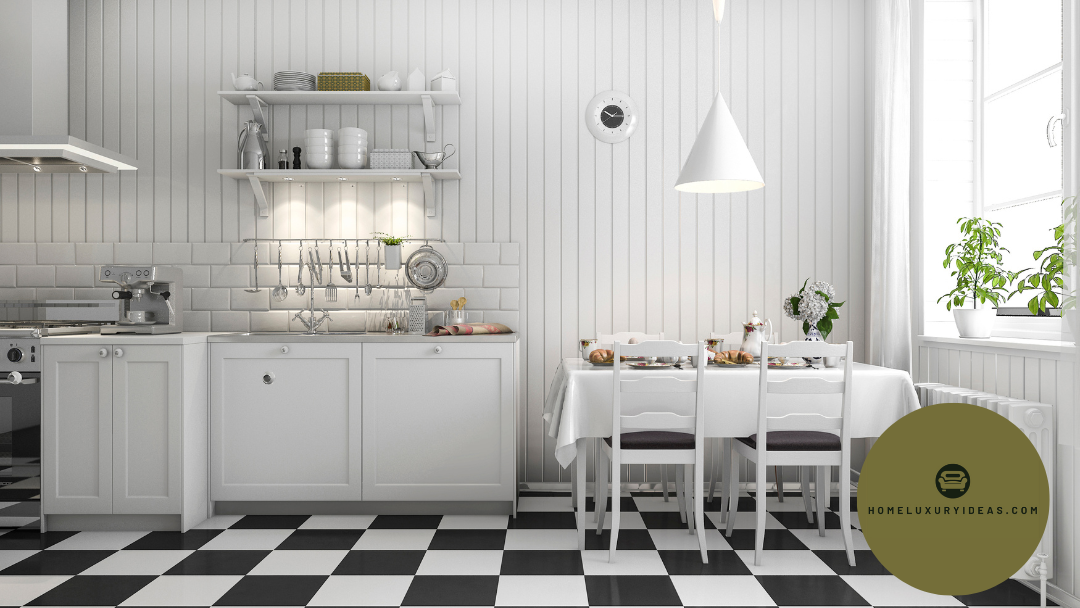The floor is often one of the least considered aspects when designing a kitchen, yet it can have a huge impact on how the space looks and feels. Kitchen floor tile designs allow you to make your kitchen a home within a home, strategically placing style alongside practicality while remaining firm and durable. This article will go over different types of tile, patterns, and trends you can use to help you make the best decision for your home.
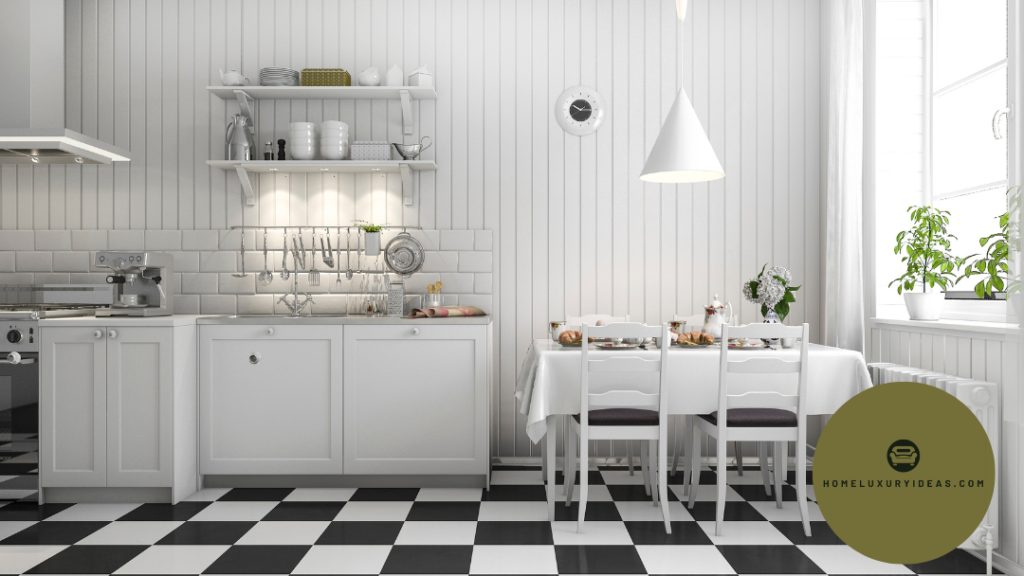
1.Why Kitchen Floor Tiles Matter
The kitchen is among the most visited parts of a house. A suitable flooring material is essential with all this constant movement, spills, and risk of heavy appliances. There are many advantages that tiles present:
The kitchen is an area of the house that needs suitable durability tiles because the tile is resistant to scratches, stains, and moisture.
Low Maintenance: Most tiles are easy to clean and maintain. All you need is a vacuum mop and some mild detergent.
Aesthetic Appeal: Tiles are available in numerous colors, shapes, and finishes that can be customized to suit your style.
Now, tile has an advantage when it comes to heat resistance since it can also withstand heat, and that helps even more in a kitchen environment.
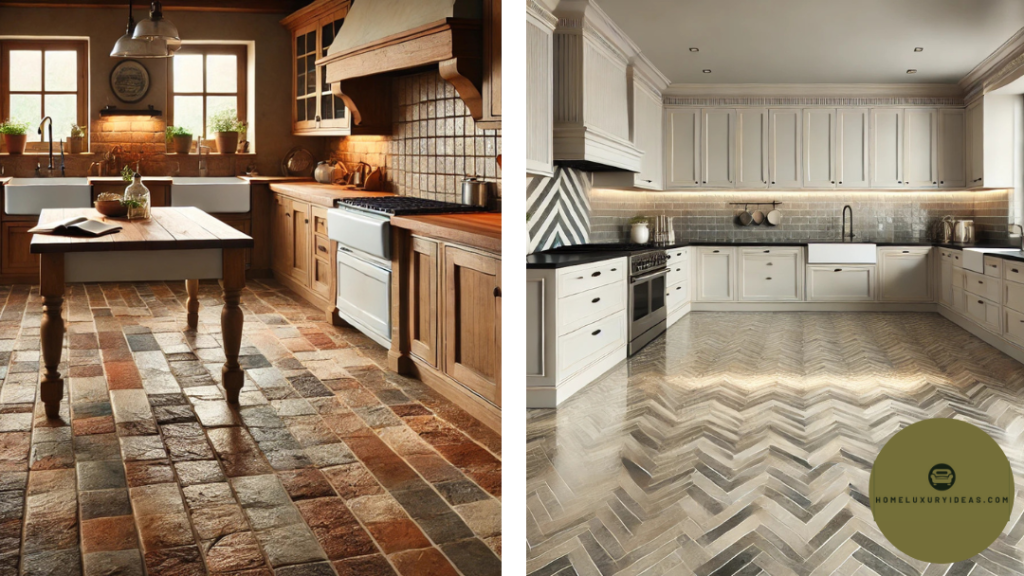
2.Types of Kitchen Floor Tiles
We know that you would love to get started with those design ideas right away, but before we get into it, let us better understand the types of tiles available in the market for your kitchen floor. Each type has its own unique characteristics that may sway your design decision.
Ceramic Tiles
One of the most used kitchen flooring options is ceramic tiles. They are extremely versatile and come in a multitude of colors, patterns, and finishes.
Pros: Affordable, solid, and low maintenance.
Disadvantages: They are cold underfoot and may crack if heavy objects are dropped.
Porcelain Tiles
Porcelain tiles are a more dense and less porous type of ceramic tile. They can imitate the look of natural stone or wood with the added benefit of being more durable.
It has many different positives, including being very water resistant and unusually durable.
The drawbacks: Usually pricier than general ceramic tiles.
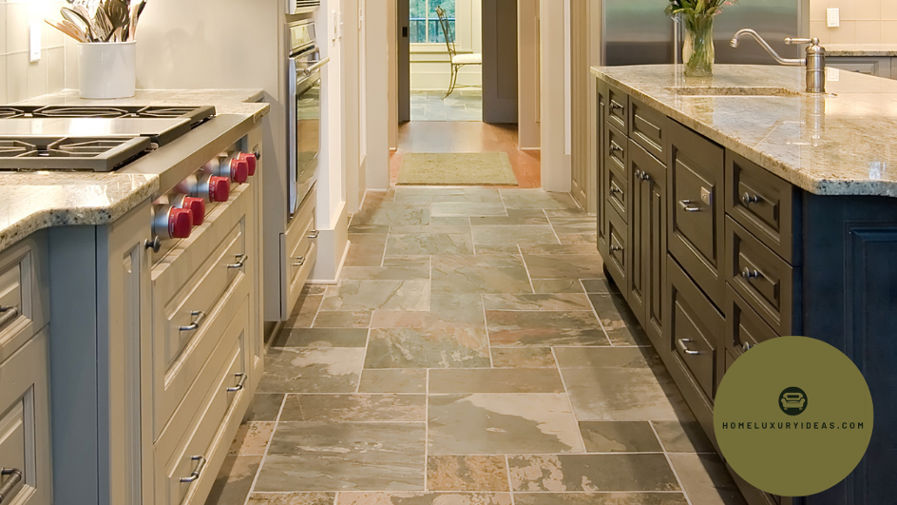
3. Natural Stone Tiles
Granite, marble, and slate are natural stone tiles that give your home an exotic, luxurious appearance.
Advantages: Individual and different textures and colors; every tile is unique.
The cons: It needs to be sealed regularly to prevent it from looking bad, and it can get pricey!
4. Vinyl Tiles
Vinyl for
Cons: Soft underfoot, easy to install, and water-resistant.
Cons: Other types are more durable and may fade over the years.
Glass Tiles
Glass tiles are always in and work wonders with kitchen design by giving a feel of modernity.
Pros: It reflects lights beautifully, making the space feel more prominent and easy to clean.
Disadvantages: It can be slippery and might need particular installation.
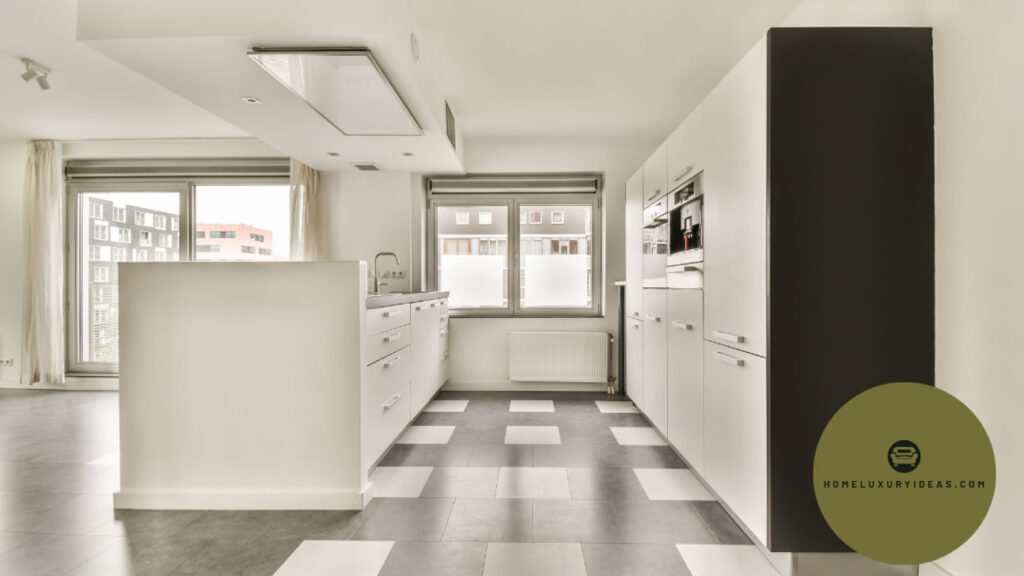
5. Popular Kitchen Floor Tile Patterns
Having learned about the varieties of tiles, let’s explore some kitchen tile design ideas that can elevate your kitchen area.
Subway Tile Patterns
The long-popular design of subway tiles will always be in favor. They are placed in a staggered approach, with rectangular tilesuna, as a simple way to create a crisp yet modern aesthetic. This design works well with glossy finishes, which bounce light away and highlight a kitchen.
Herringbone and Chevron Patterns
Herringbone and chevron patterns are always a great way to bring an element of high-end design into your kitchen. You can create these patterns with rectangular tiles; ceramic and natural stone tiles work great. Try to use colors that contrast a little, creating visual interest.
Mosaic Designs
With mosaic tiles, you can get really creative and custom. You can utilize small tiles of different hues and styles to form elaborate designs. This option is best suited for a statement floor that embodies your style.
Large Format Tiles
One look that has become popular is achieved by large-format tile, which removes or minimizes grout lines. These tiles reduce grout filling and can make a compact kitchen look more spacious. They look great in modern decor.
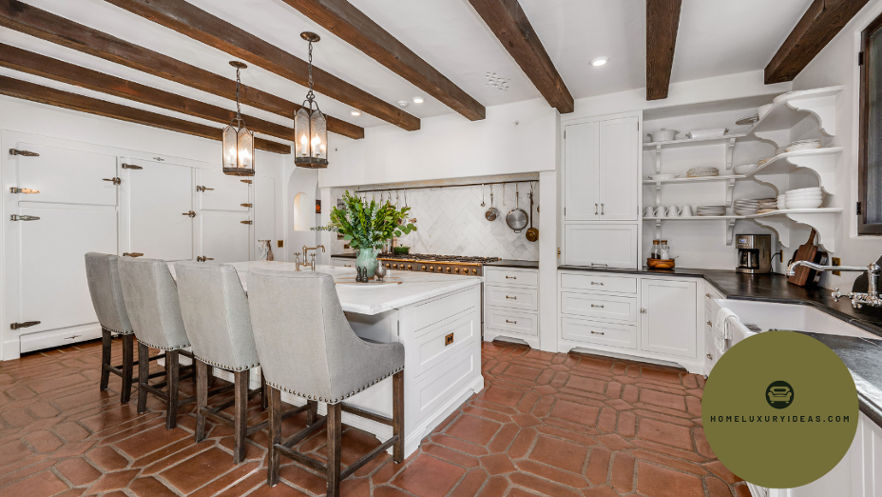
6. Additional Considerations for Kitchen Floor Tiles
| Category | Details |
|---|---|
| Eco-Friendly Options | Mention eco-friendly tiles such as recycled glass or sustainably sourced ceramic tiles. |
| Cost Comparison | Provide a table comparing the cost ranges of different tile types (ceramic, porcelain, stone, etc.). |
| Installation Time | Add average installation time for each tile type. |
| Underfloor Heating Compatibility | Highlight which tiles (e.g., porcelain or ceramic) are best suited for underfloor heating systems. |
| Tile Thickness | Specify the typical thickness range for each type of tile. |
| Scratch Resistance Rating | Include how tiles rate in terms of scratch resistance (e.g., PEI rating for ceramics). |
| Sustainability Certifications | Add common certifications like GreenGuard or LEED compliance for eco-conscious buyers. |
| Tile Edge Options | Discuss beveled vs. straight edges and their impact on appearance and grout lines. |
| Custom Designs | Mention the possibility of laser-cut custom designs or logos on tiles. |
| Tile Resilience in Cold Climates | Address which tiles are better for areas with cold weather (e.g., frost-resistant porcelain). |
| Slip-Resistance Rating | Add ratings like R10 or R11 to indicate slip resistance for specific tiles. |
| Grout Innovations | Introduce advancements like stain-resistant or epoxy grouts that enhance durability and maintenance. |
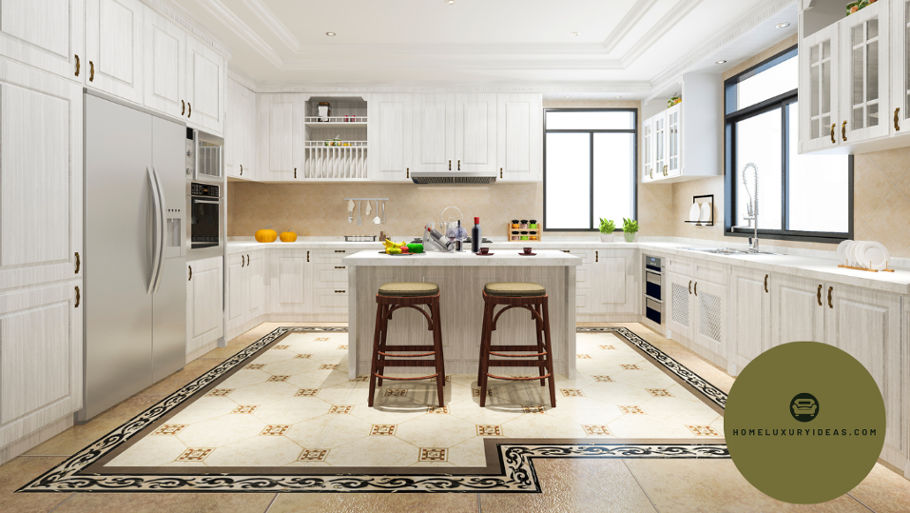
7. Rustic and Farmhouse Styles
If you’re after a rustic look, check out distressed or textured ceramic tiles and those that mimic the feel of reclaimed wood or weathered stone. These tiles are pretty warm and look beautiful when used in the kitchen.
8. Kitchen Floor Tile Color Trends
Selecting the proper color is essential to reach the right temperament in your kitchen. The following are some color trends for the kitchen floor tiles:
Neutral Tones
Neutrals such as beiges, grays, and whites will always stay in style. These shades also promote a quiet, welcoming ambiance for clients. Additionally, this will give you more flexibility when selecting cabinets and countertops.
Bold Colors
For a more statement look, I’d suggest using bolder colors, such as dark blue/green or bright yellow. Plenty of colors out there bring a bit of character and excitement to the space.
Earthy Hues
Brown colors, like terracotta, for example, can create a sense of warmth and earthiness. These are great colors for rustic and farmhouse-styled kitchens.
Black and White
The classic black-and-white pairing always works. This design can be modern or vintage, depending on the tile shape and pattern.
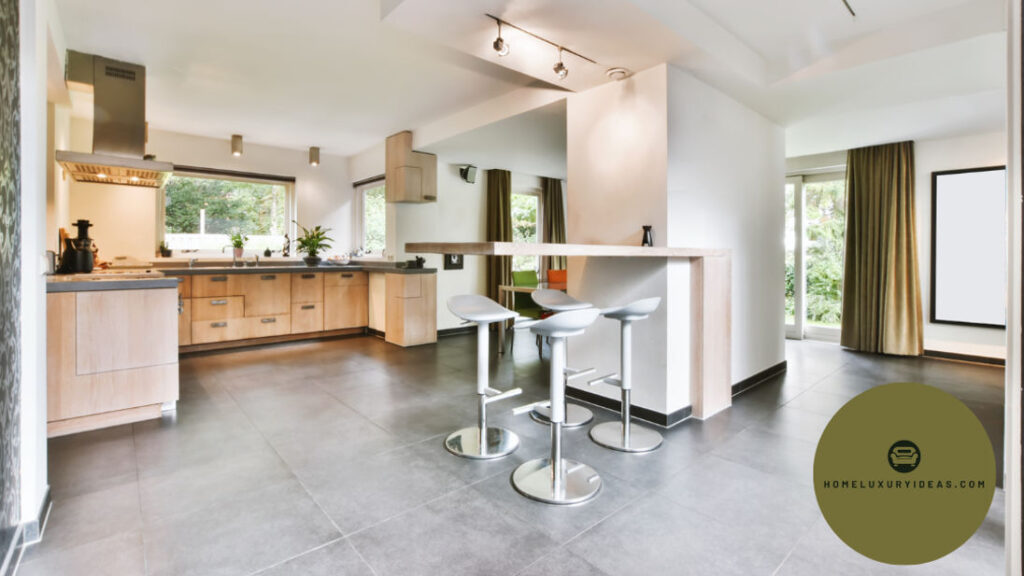
9. Texture and Finish Options
Your tiles also play a significant role in defining the texture and finish of your kitchen. Here are some possibilities to consider:
Glossy Finish
Glossy Tiles Reflect Light and Create the Illusion of a bigger space. Ghost chairs are perfect in small kitchens but may need more elbow grease to keep them clean and pristine-looking.
Matte Finish
They give a more delicate touch and are sometimes easier to maintain. This is because they are not as slippery, making them a safer option for high-traffic places.
Textured Tiles
The textured tile adds depth and interest to the floor. It can imitate natural materials such as stone or wood, giving the kitchen a more organic appearance.
10. What to Look for in Kitchen Flooring Tiles
Here are some tips to help you choose the right kitchen tile design for your floor:
11. Durability and Maintenance
Think about the foot traffic your kitchen experiences. If it is a busy area, choose hardworking tiles.
Slip Resistance
Getting back to the kitchen category, safety comes first. Opting for a slip-resistant finish on your tiles is a good choice, as you might be busy cooking and cleaning.
Style Compatibility
Use tiles that complement your kitchen’s overall design. From modern to traditional to rustic, the right tiles can elevate your aesthetic.
Budget
Budget, Budget, Budget$ One is luckier to be the 1% of the population that needs to set a budget for things! Setting a budget can save you money and time but, above all, gives your kitchen floor project some focus. Since tiles come at varied prices, you need to include only those tiles that will fit your financial plan and help achieve the desired design.
12. How to Install Kitchen Floor Tiles
Proper installation is necessary to ensure the longevity of your kitchen floor tiles. A few tips to consider are:
Prepare the Subfloor
Verify that your subfloor is clean, dry, and level before laying tiles. Even the pin-head imperfections affect the whole.
Use the Right Adhesive
Select an adhesive suitable for the type of tile you are using. If you are unsure, ask a professional for help.
Allow for Expansion
Leave a small gap around the edge of the tiles for expansion and contraction. This will help prevent cracking from reoccurring.
Grouting
Pick grout colors that depend on the tile color and follow their room condition. Well-done grouting can improve the overall aesthetics of your floor.
13. Keeping Up With Cleaning Kitchen Floor Tiles
If you want to maintain the aesthetic of your kitchen floor tiles, consider these maintenance tips:
Regular Cleaning
Sweep or vacuum up dirt and debris. Release Date: October 2023. For shine, use a damp mop with mild detergent for cleaning.
Address Spills Promptly
Do not allow spills; clean them up instantly to avoid staining. Most tiles are stain-resistant anyway but take care.
Seal When Necessary
Natural stone tiles must be sealed regularly so that water cannot penetrate them and cause damage or stains. Seal your surface according to the manufacturer’s recommendations.
14. Frequently Asked Questions (FAQ)
What types of tiles for kitchen flooring should be used?
Here are the best types of tiles to use for a kitchen floor: ceramic tile, porcelain tile, natural stone, and vinyl tile. They each provide unique advantages like durability, upkeep, and beauty. Porcelain tiles are suggested for high-traffic locations because of their higher durability.
What factors must one consider while selecting the right kitchen tile color?
If you’re wondering how to choose tile colors, think again about your kitchen theme. Colors like whites and grays offer flexibility, while bright colors can bring a lively touch. Earthly hues create warmth, and black-and-white combinations add timeless class. It’s additionally useful to consider how the color will complement cabinets and countertops.
Cleaning difficulty of textured tiles – are they lesser?
Textured surface tiles are more complex to clean than smooth surfaces. However, they do have better slip resistance than most tiles, which can be important in a kitchen environment. If maintained correctly and using the correct type of cleaner, these can help keep them looking as good as the day you bought them.
Making Kitchen Floor Tiles Less Slippery — The How-to Guide?
Select the ideal finish — as it helps in increasing slip resistance. Also, place area rugs in high-traffic zones to add stability and softness. Before discussing the slip resistance of tiles, it should be noted that other factors also affect the slip resistance of tiles – always ensure to install them properly.
Is it possible to lay kitchen floor tiles on my own?
Indeed, many individuals actually set up ceramic tiles in their own cooking areas. But it needs planning and best practices to follow. If this is the first time you are laying down turf, consult a professional to get it right.
How do you care for kitchen floor tiles?
Our cleaning method involves Sweeping or vacuuming to eliminate debris, mopping with a neutral detergent, and immediate response to any spillages. Natural stone tiles will need periodic sealing to keep them stain-resistant. For specific maintenance recommendations, always check the manufacturer’s guidelines.
How much do kitchen floor tiles cost on average?
Kitchen floor Tiles can cost anywhere from a price price more to price up depending on the material, size, and style. Ceramic tiles cost between $1 and $5 a sq. ft., while porcelain tiles range from $3 to $10 a sq. Natural stone tiles are more costly, typically costing between $5 and $20 per square foot.
What unique tile design could I use in your kitchen?
Experiment with individualistic design through a tile mosaic pattern, the use of distinctively shaped tiles, or bold colors and textures. You can also use it for a statement area (like in the kitchen with a backsplash and some floor space).
Do you have questions about kitchen floor tile design or need help?
Keep browsing your options, or ask a flooring pro!
15. Conclusion
Investing in the best kitchen floor tile designs can add to your house’s beauty and functionality when appropriately done and chosen. When you know about the different types of tiles, look at the design trends, and are also mindful of practical aspects, you will be able to make an informed decision for your home. After all, the kitchen is the heart of the house and can only be better with flooring that invites everyone to stay for a while and enjoy it.
<script type="application/ld+json">
{
"@context": "https://schema.org",
"@type": "BlogPosting",
"mainEntityOfPage": {
"@type": "WebPage",
"@id": "https://homeluxuryideas.com/best-kitchen-floor-tile-designs/"
},
"headline": "Best Kitchen Floor Tile Designs 2025: Elevate Your Space with Style and Functionality",
"description": "Best Kitchen Floor Tile Designs 2025: Elevate Your Space with Style and Functionality",
"image": "https://homeluxuryideas.com/wp-content/uploads/2024/11/Kitchen-Floor-Tile-Designs-1024x576.png",
"author": {
"@type": "",
"name": ""
},
"publisher": {
"@type": "Organization",
"name": "",
"logo": {
"@type": "ImageObject",
"url": ""
}
},
"datePublished": ""
}
</script>
